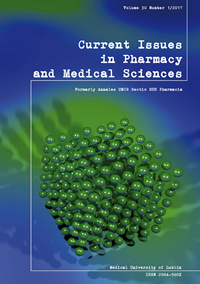The use of the Gelot emulsifier in diclofenac sodium semi-solid preparations
DOI:
https://doi.org/10.1515/cipms-2017-0010Keywords:
diclofenac sodium, emulsifiers, rheology, pharmaceutical availabilityAbstract
In topical formulations, the rheological parameters and pharmaceutical availability of many active agents have been improved by the addition of modern excipients. This translates into increased interest in the topical use of NSAIDs. The aim of this study was to create series of effective oil in water (O/W) diclofenac sodium cream formulations that differ in the applied fatty phase, utilizing GelotTM64 (Gattefosse) (a modern non-ionic emulsifier). In the produced prescriptions, estimation was made of the effect of this on the rheological parameters and the pharmaceutical availability of the diclofenac sodium. Herein, the hydrophilic petrolatum-based cream demonstrated the highest rate of release of the active agent, as well as the best set of beneficial rheological parameters.
References
1. Alexander A. et al.: Approaches for breaking the barriers of drug permeation through transdermal drug delivery. J. Controlled Release, 164, 26, 2012.
2. Asasutjarit R. et al.: Optimization and evaluation of thermoresponsive diclofenac sodium ophthalmic in situ gel. Int. J. Pharm., 411, 128, 2011.
3. Cal K.: Nowoczesne metody podawania substancji leczniczych przez skóręw nowych obszarach terapeutycznych na przykładzie transdermalnych systemów terapeutycznych (TTS). Aptekarz Polski, 70/48, 2012.
4. Cal K., Stefanowska J.: Metody zwiększania przenikania substancji leczniczych przez skórę. Farmacja Polska, 66, 514, 2010.
5. Cevc G., Blume G.: New, highly efficient formulation of diclofenac for the topical, transdermal administration in ultradeformable drug carriers. Transferosomes. Biochim. Biophys. Acta, 1514, 191, 2001.
6. Chaudhary H., Kohli K., Kumar V.: Nano-transferosomes as a novel carrier for transdermal delivery. Int. J. Pharm., 454, 367, 2013.
7. Chiarini A., Tartarini A., Fini A.: pH-solubility relationship and partition coefficients for some anti-inflammatory arylaliphatic acids. Arch. Pharm., 317, 268, 1984.
8. Cordero J.A. et al.: A comparative study of the transdermal penetration of a series of nonsteroidal antiinflammatory drugs. J. Pharm. Sci., 86, 503, 1997.
9. Farmakopea Polska X TOM I, (2014). Fizyczne i fizykochemiczne metody badania - Pomiar pH metodą potencjometryczną. Polskie Towarzystwo Farmaceutyczne, p. 110.
10. Farmakopea Polska X TOM I, (2014). Metody badania postaci leku - Uwalnianie substancji czynnej z systemów transdermalnych. Polskie Towarzystwo Farmaceutyczne, p. 393.
11. Fouad S.A. et al.: Microemulsion and poloxamer microemulsionbased gel for sustained transdermal delivery of diclofenac epolamine using in-skin drug depot: In vitro/in vivo evaluation. Int. J. Pharm., 45, 569, 2013.
12. Fuller P., Roth S.: Diclofenac sodium topical solution with dimethyl sulfoxide, a viable alternative to oral nonsteroidal antiinflammatories in osteoarthritis: review of current evidence. J. Multidiscip. Healthc., 4, 223, 2011.
13. Ioele G. et al.: The difficulties for a photolabile drug in topical formulations: The case of diclofenac. Int. J. Pharm., 465, 284, 2014. [Web of Science]
14. Kalhapure R.S., Akamanchi K.G.: Oleodendrimers: A novel class of multicephalous heterolipids as chemical penetration enhancers for transdermal drug delivery. Int. J. Pharm., 454, 158, 2013. [Web of Science]
15. Lane M.E.: Skin penetration enhancers. Int. J. Pharm. 447, 12, 2013. [Web of Science]
16. Łubkowska B., Grobelna B., Maćkiewicz Z.: Przenikanie składników aktywnych przez skórę. Pol. J. Cosmetol., 15, 33, 2012.
17. Milao D. et al.: Hydrophilic gel containing nanocapsules of diclofenac: development, stability study and physico-chemical characterization. Pharmazie, 58, 325, 2003.
18. Mohammadi R., Hirsaee M.A., Amini K.: Improvement of functional recoveryof transected peripheral nerve by means of artery grafts filled with diclofenac. Int. J. Surg., 11, 259, 2013.
19. Mora M.J., Longhi M.R., Granero G.E.: Synthesis and characterization of binary and ternary complexes of diclofenac with a methyl-beta-CD and monoethanolamine and in vitro transdermal evaluation. Eur. J. Med. Chem., 45, 4079, 2010. [Web of Science]
20. Mudshinge S.R. et al.: Nanoparticles: emerging carries for drug delivery. Saudi Pharm. J. 19, 129, 2011.
21. Pando D. et al.: Formulation of resveratrol entrapped niosomes for topical use. Colloids and Surfaces B: Biointerfaces, 128, 398, 2015.
22. Pawlik-Gałczyńska A., Owczarek A., Pluta J.: Skóra jako droga podania substancji leczniczych. Część I. Budowa skóry, wchłanianie leków przez skórę. Farmacja Polska, 63, 287, 2007.
23. Sayen S. et al.: A novel copper (II) mononuclear complex with the non-steroidal anti-inflammatory drug diclofenac: Structural characterization and biological activity. J. Inorganic Biochem., 120, 39, 2013.
24. Shahzad Y. et al.: Breaching the skin barrier through temperature modulations. J. Control Release, 202, 1, 2015. [Web of Science]
25. Sharquie K.E. et al.: Treatment of pityriasis versicolor using 1% diclofenac gel and clotrimazole cream (comparative therapeutic study). J. Saudi Soc. Dermatol. Dermatol. Surg., 15, 19, 2011.
26. Silva N.H.C.S. et al.: Bacterial cellulose membranes as transdermal delivery systems for diclofenac: In vitro dissolution and permeation studies. Carbohydrate Polymers, 106, 264, 2014. [Web of Science]
27. Sintov A.C., Botner S.: Transdermal drug delivery using microemulsion and aqueous systems: influence of skin storage conditions on the in vitro permeability of diclofenac from aqueous vehicle systems. Int. J. Pharm., 311, 55, 2006.
28. Technical data sheet - Gelot 64; http://www.gattefosse.com/
29. Wadhawa J., Nair A., Kumira R.: Emulsion forming drug delivery system for lipophilic drugs. Acta Pol. Pharm., 69, 179, 2012.
30. Zacher J. et al.: Topical diclofenac and its role in pain and inflammation: an evidence-based review. Curr. Med. Res. Opin., 24, 925, 2008. [Web of Science]
31. Zgoda M.M., Kołodziejska J., Godlewska M. (2008). Metody badania wybranych środków farmaceutycznych i kosmetyków. Wydawnictwo Kwieciński p. 8.
Downloads
Published
Issue
Section
License
Copyright (c) 2017 Authors

This work is licensed under a Creative Commons Attribution-NonCommercial-NoDerivatives 3.0 Unported License.


